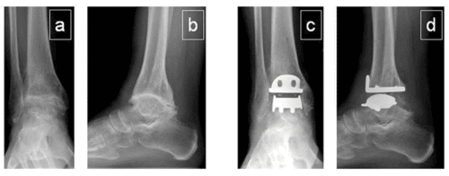Better function, few complications seen with minimally invasive TAR technique
However, surgeon warns of risks during this formative stage of total ankle arthroplasty.
Click Here to Manage Email Alerts
Early results indicate that minimally invasive total ankle replacement may provide good functional outcomes and a low complication rate in patients with severe ankle arthritis, according to researchers from Germany.
“Minimally invasive total ankle replacement is possible,” Dan-Henrik Boack, MD, said during his presentation at the American Orthopaedic Foot and Ankle Society annual summer meeting. “We can achieve good clinical results and high patient satisfaction. But, at this time we only have short-term results. We have to evaluate our patients again.”
William C. McGarvey, MD, a moderator for the session and Orthopedics Today Editorial Board member, noted that ankle replacement is in its formative stages and said that techniques that reduce visibility and add potential risk factors are unwarranted at this time.
“I am not an advocate of this technique and I think research in other joints through minimally invasive approaches have borne this out,” McGarvey told Orthopedics Today. “I think that if you have large numbers of surgeries and are able to do this regularly, you can get comfortable with a smaller incision, but to shorten the incision routinely for the sake of a smaller scar may be done at the expense of accuracy of implantation or risk to soft tissues.”
|
Images: Boack DH |
Technique
Boack prospectively studied 85 total ankle replacements (TARs) that he performed using a minimally invasive technique between 2007 and 2009. The patients had modified Kellgren-Lawrence grade IV ankle arthritis and an average age of 61 years.
During the procedure, Boack used a short median approach and performed a 5-cm to 6-cm skin incision.
“The important thing is to leave the anterior tibial tendon complete in the tendon sheet,” Boack said. He performed the procedures without subperiosteal bone preparation and explored the ankle with a moving window technique.”
He percutaneously fixed the aiming cutting device under fluoroscopic control and resected the dorsal portion of bones using a bit-by-bit technique. Finally, he implanted the cementless implant.
Postoperatively, the patients were prescribed 2-days bed rest and started mobilization on the third postoperative day.
Boack noted that a longer incision of about 1 cm was needed for two cases. The investigators found two extensor hallucis tendon lesions that were associated with the technique. These complications occurred in the first 10 cases. They also discovered one suture granuloma and malleolar fracture which were not linked to the minimally invasive technique.
|
|
|
Results
Using an image intensifier to measure ankle motion, the investigators found that the average sagittal range of motion increased from 23° preoperatively, to 55° postoperatively. Also, the overall average ankle range of motion improved from 18· preoperatively, to 41° postoperatively.
The investigators also compared the patients with a group of 171 patients who underwent TAR using a conventional approach between 2007 and 2009. They discovered that the minimally-invasive treated patients had a 9° loss of motion from initial postoperative results to final follow-up, while the conventional group had a 16° loss of motion.
“This was surprising for us, and maybe this technique helps us to control this,” Boack said.
Radiographic evaluation at final follow-up also revealed osseous bonding in all of the patients who underwent the minimally invasive technique, and no cases of instability, loosening or heterotopic ossifications.
For more information:Dan-Henrik Boack, MD, can be reached at Center of Musculoskeletal Surgery, Charité Campus, Virchow-Clinic, Augustenburger Platz1 D-13353, Berlin, Germany; 49 1803-22-11-211; e-mail: dhb@foot-ankle.biz. He has no direct financial interest in products or companies mentioned in this article.
William C. Garvey, MD, is an associate professor at the University of Texas in Houston, 6410 Fannin, Suite 950, Houston, TX, 77030. He can also be reached at Katy Orthopaedics, 23920 Katy Freeway, Suite 160, Katy, TX 77494; 281-392-6797; e-mail: william.c.mcgarvey@uth.tmc.edu. He is a part of the speakers bureau for DePuy, is an unpaid consultant for Arthrex and receives research support from Arthrex, Biomet, DePuy, Smith&Nephew and Stryker.
- Reference:
Boack D, Manegold S. Minimal invasive technique of total ankle replacement. Presented at the 25th Annual Summer Meeting of the American Orthopaedic Foot and Ankle Society. July 15-18, 2009. Vancouver, British Columbia.



